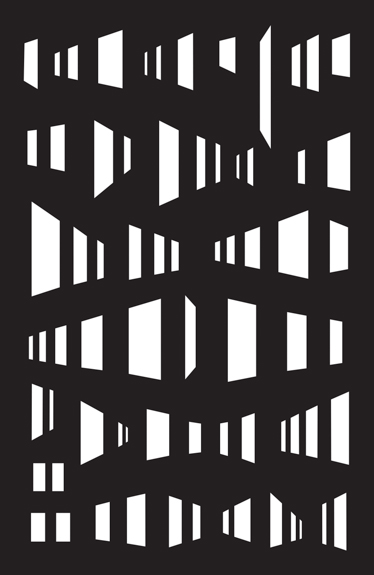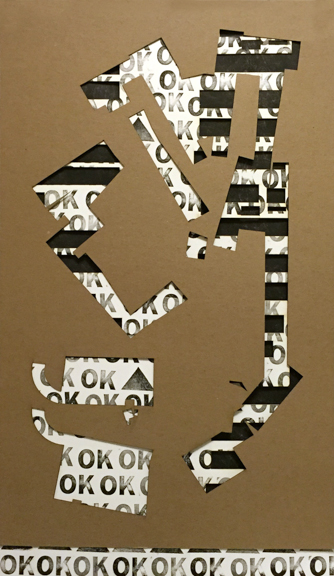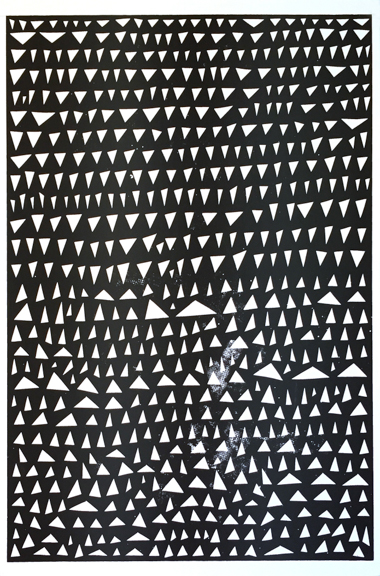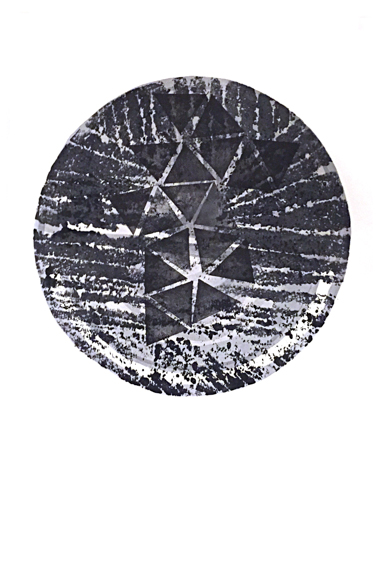Janine Biunno
Janine Biunno is a visual artist based in Brooklyn, NY whose work typically analyzes and interprets the semiotics of the built environment. Janine's artwork addresses the subjective practice of understanding and representing the architecture, infrastructure and density of urban space, and how our general perception of those physical spaces is altered due to the increasing influence of the digital realm. Janine's work primarily manifests itself two-dimensionally, as prints, drawings, books and other works on paper. Janine received her BFA from Carnegie Mellon University and MFA from Tufts University in conjunction with the School of the Museum of Fine Arts, Boston. When not making art, Janine works with world renowned architect, Steven Holl, as the Director of Publications, Exhibitions, and Archives.
Statement
Janine Biunno’s work examines the relationship between how we read digitally represented space and how that information influences our understanding of the cities we occupy. While the architectural space in her work is given a marked iconic quality through its reference to well known landmarks, the static image of these structures is opened up and the viewer is invited to travel within them. Transforming fixed image into fluid architectural space, the work is animated by a process of parallax between the viewer’s actual and perceptual movement, the represented architecture, and the work of art. Similarly, our newfound capabilities to explore space via digital means presents us with another perspective for experiencing and interpreting the built environment. Our relationships with familiar locations have been altered and the disconnect between physically experienced space and virtually explored space has been widened, yet we are familiar with more places than ever before.
Janine in her Brooklyn studio.
Q&A with Janine Biunno
by Emily Burns
Can you give us some insight into your process? How do you begin and how do you create your compositions?
It varies from piece to piece, but for the black paper cutouts (and also for a lot of my zines) I usually start with a Google image search for a specific piece of architecture or infrastructure, a building type, or by collecting similar images that I photograph myself as I travel throughout the city. I gather images until I’ve aggregated enough information for a single idea or shape to become evident. I typically build the compositions in Illustrator (or InDesign for the zines) and will mess around with a million different layers until I come up with an arrangement that I like. I will then use that as a template to cut from by hand, but also will make adjustments as I go. Sometimes I skip the Illustrator phase, and go directly to cutting; sometimes the process falls somewhere in-between.
In your statement, you talk about how our perception of physical spaces is altered due to the increasing influence of the digital realm. Are there any parallels with this shift in the art world and how we increasingly view works of art online?
Definitely. In viewing art online, I think it depends on the intention of the work & if you are approaching it as a representation or instead an artwork that was created for being experienced via a web/digital platform, but that said, I think in terms of accessing and exploring more information (art and otherwise), because of the internet we do find ourselves more informed than ever before—but is seeing art online the same thing as seeing it in person? is seeing a picture of Paris the same as being there? Clearly not, but it doesn’t mean that it can’t help us understand more about the world around us and direct us to new material. I don’t think that one can replace the other, but one certainly can support the other.
How does your process relate to the themes and relationships in your work?
In my work, I am focusing on the subjectivity of this (aforementioned digital) experience, specifically in terms of how we filter and understand this inundation of data that has become the new normal. I spend a good part of my day collecting and organizing information as part of my job but also as a means of logging my ideas and influences. I use Tumblr to collect visual resources that I find exclusively on the internet and I use my phone’s camera to track my physical surroundings in the city as I experience and encounter them. This constant culling of information is the closest thing I have to a sketchbook, and ultimately the first step to how I create any work of art. I think my art is a visual representation of my attempt to distill order from a noisy/infinite subject.
What source material do you use for the architecture you reference? How do you choose the references?
I like to focus on structures that have been deemed iconographic by design. This means buildings or infrastructure that were built to exist as identifiers for locations, or at least have grown to take on that meaning. These structures have existed in many forms over the ages, but I’m mostly interested in buildings that were created after Frank Gehry’s Guggenheim Museum opening in Bilbao (1997). That museum began a new era of building architecture with the goal that through design (and arguably, culture) it would revive postindustrial cities, which is known in the architecture community as the Bilbao Effect. I am also interested in structure that is identifiable because of one’s experience or interaction of it within a city. The mental mapmaking that occurs in your daily life is called psychogeography, and it is the other way I decide what architecture/structure I cite in my work. I try to strike a balance in focusing on structures that I have only seen via the Internet and those that I have actually seen in person.
Can you talk about the importance of color in your work?
I like to use color that references the environment I am investigating (for example: my MFA thesis was a depiction of Boston permanently under construction, and it was made only with steel gray, graphite, and safety orange.) Currently, my work is an investigation of form and void, and is largely informed by Constructivism. The choice to limit color happened somewhat organically as my work leaned more towards the minimal. I’m sure color will make a return eventually, but right now everything is primarily in black and white.
In your recent exhibition at Transmitter Gallery in Brooklyn, you also included your zine, Future Systems, which is currently available through Transmitter website. Can you talk a bit about this project? Is it ongoing? Do you produce the issues yourself?
Zines have been a part of my practice well before I had an “art practice”. I started making zines with my friends in high school, and we would hand them out or trade them at local punk rock shows. It was a fun project at the time, but ended up being hugely influential with certain themes that still ring true in my current work. I have always valued DIY culture and the ability that zines (and print media in general) have to allow for the egalitarian dissemination of information.
Future Systems was created specifically to accompany the 4 cutouts that I produced for that exhibition (only 3 were exhibited,) and was a way to explore physical space via bookspace. I tend to create minimal work that is densely informed, which sometimes is not evident upon first glance. This specific zine allowed me to give some clues as to how I derived the final compositions of the large cutouts that were on display. I’ve used zines as this kind of tool before, but I also make many that are not connected to other works.
At the moment I am working on a few book/zine projects concurrently, one of which will be a part of Liber Mundi, a traveling art book exhibition this year. I produce all issues myself, with varying degrees of craftsmanship. I studied bookarts while in grad school, so sometimes I enjoy make hardbound volumes, with hand sewn bindings, and things of that nature—but more often than not I produce your “traditional” type of photocopied type of zine.
What is a typical day like for you?
I work a 9–5 job as the head archivist at the Noguchi Museum in Long Island City. As a research-driven artist, I find that I can best create when I am immersed in an idea. I’ve been fortunate to have the opportunity of working within fields that inform my art (I previously was the Director of Publications, Exhibitions, and Archives for conceptual architect, Steven Holl before this current post). Not to take the question too off track, but due to having a somewhat rigid work schedule, work and artmaking have had to strike a balance. I work from 95, but am always thinking and taking notes and collecting images when I have down time throughout the day. I see art whenever I have time on weekends and after work, and constantly via the internet. Since 2011, I keep a daily tumblr to track things that influence me; it is a combination of art, design, architecture, “found” photos from Google Image Search, and the occasional hip hop video (just because.) I’m always photographing my surroundings and looking for patterns to extract and turn into something else. On occasion—typically on the weekend, I will have a studio day to make work. This doesn’t happen as often as I like. In terms of actual “art making”, I tend to work in bursts that occur every month or so, as opposed to steadily toiling away.
Can you describe your studio space? What are your most important workspace essentials?
My studio is a room in my apartment. I originally started working from home because the space was there and it meant one less expense by not renting a separate studio. I work primarily on paper, so there is a lot of that around. I am pretty organized, so it is a tidy space. I’m most proud of the set of flat files I scored off of Craigslist for $50 when I was living in Boston. I’d definitely consider it an essential, considering my medium(s). Other essentials include a huge cutting mat, and nice table with screenprinting clamps, and an endless supply of X-Acto knives.
What do you listen to while you work? Is this an important part of your practice?
What I listen to varies from day to day, but I’m a bit of a hip hop head & like to keep up to date on what is happening in that realm. I keep a Soundcloud account that I update pretty regularly with mixtapes and tracks that I like and I mostly listen to that while I work. I love music SO much, but it honestly has very little to do with my practice. It is just another thing that I care about.
Has there ever been a book/essay/poem/film/etc. that totally changed or influenced you? What are you reading right now?
This is a very “art school” answer but I’d be lying if I didn’t say that Walter Benjamin’s The Work of Art in the Age of Mechanical Reproduction and Marshall McLuhan’s The Medium is the Message didn’t impact my practice in profound ways. I have read both (especially the Benjamin essay) countless times over my years in school and especially while I was studying printmaking, but both made me really consider what I was making and how/why I was making it. Those ideas still inform my practice.
I’m currently reading Roxane Gay’s Bad Feminist and Everything and Nothing by Borges. Both are collections of essays and stories, so I’ve been jumping back and forth. I do most of my reading while I commute.
What are some of the artists that you look at feel that your work is in dialogue with?
Contemporarily speaking, I think the work of Tauba Auerbach, Math Bass, and Alain Biltereyst. On an art historical level: Malevich, Anne Truitt, and Sol LeWitt. Also: Lygia Pape, Helio Oiticica and the Concretists.
Do you have any advice for recent grads that are looking for teaching jobs, transitioning out of graduate school, or looking to begin their career as studio artists?
Post MFA, my best advice is don’t limit yourself to just finding a teaching job, despite the fact that was what may have initially motivated you to get an MFA. The current climate is not in favor of the professor; full-time positions are few and far between and universities are taking advantage of adjuncts to a scary degree. I absolutely loved teaching while in grad school, but had to come to the harsh reality that it probably was not how I was going to earn my living, at least not immediately. I’m definitely not saying to give up on teaching if that is really what you want to do, but maybe consider other ways you can apply your skills. Think about what informs your artwork and pursue working in a field related to that. Also, I think this gets overlooked because art education is often devalued, but art school makes you super resourceful. Apply all the skills you’ve acquired over the years and think outside the box. No matter what career path you choose, if you want to have a studio practice you need to find a way to make time for it. Don’t be too hard on yourself at first; going from working on your art full-time while in school to balancing your art practice and the “real world” takes a little time. Also, apply to residencies! I’ve found that without having summers off, I needed to find a way to focus on just my artwork for extended periods of time. For me, I sought out 2 week residencies that still fit within my work vacation schedule. Obviously, do what works best for you, but I can’t say enough about how valuable time at a residency can be when you are otherwise struggling to fit art making into a busy work life.
Do you have any advice for emerging artists looking to get involved in exhibitions and gain an audience for their work?
Go to shows. See all the art you can and find the galleries that seem like they could be good for you and get to know the people involved. Be present. Connect with people as much as possible. Join a crit group. Ask for (or offer to give) studio visits. Don’t be shy.
You curated a show that included wallpapers titled Rerun: The Relation Between a Symbol and a Symptom. Has wallpaper or pattern been a specific interest of yours in the past?
Not wallpaper specifically, but pattern, yes. I have a fascination with how design can sublimate information in certain formations. I’ve always had an interest in information design and “sign” (or pictogram) language and it has continually influenced the aesthetic of my work.
Do you have an interest in curatorial roles in the future?
Not necessarily in terms of curating exhibitions at the moment, but I have an idea for a zine group project in the near future that borders on “curatorial”. Despite how much I enjoy research and culling information in my own art practice, I don’t see myself as a curator. I’ve had a few curatorial projects over the years and I know there is a lot of gray area between the roles of artist and curator more and more these days, but I still find myself squarely on the artmaking side of things more often than not.
What influenced your decision to move to New York after graduate school? What is your experience of the art scene in Brooklyn?
I came to Brooklyn after grad school for a job in the design/architecture industry in 2008 and it took me a little bit of time to find a place in the art scene here, mostly because I had some exhibitions coming up in Chicago that were keeping me busy as well as a new (full-time) job. When I first got here I had already exhibited a little bit in NYC so I was fortunate to continue to have work in some group shows at IPCNY in Chelsea—so it was a couple of years before I really started to get involved with what was happening in Brooklyn. My experience here has been positive, and you get what you give.
Do you have any exciting news or shows coming up?
I will have work in Liber Mundi, a series of artist book and zine exhibitions organized by J. Pascoe and will also be recording an episode for the Clocktower Radio podcast: Paper Cuts, hosted by Christopher Kardambikis in the near future. Hopefully a couple other exhibitions on the horizon, but too soon to say!
Thanks so much for sharing your work and talking with us!
Find out more about Janine and her work on the artist’s website.













